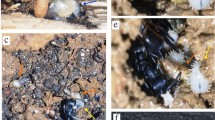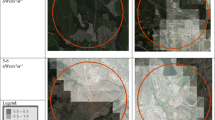Abstract
Bird nests are designed to contain and protect parents, eggs and nestlings and to facilitate optimal safety and climatic conditions from egg-laying to fledging offspring. Bird nests also provide optimal conditions for a rich and diverse community of mainly invertebrates, who use nests as a foraging site, shelter, hiding place and reproduction and overwintering site. So far, no study has experimentally examined the impact of other nest inhabitants, except for parasites, on nestling development. The aim of this study was to investigate the impact of a saprophagous fly larvae Fannia spp. on nestling European Bee-eaters (Merops apiaster). We hypothesize that, if Fannia spp. larvae improve nest sanitation due to their detritivorous habits, increased larvae abundance would result in improved chick growth and health. Thus, to investigate the impact of Fannia spp. larvae on nestling Bee-eaters, we experimentally manipulated their abundance during the early nestling period and determined parameters indicative for nestling body condition and health. The experiment confirmed our prediction and revealed that increasing the number of saprophagous fly larvae had a positive effect on offspring condition. We suggest that bird nest fauna other than parasites might be as important and could be used as a model for ecosystem analyses. Bird nests usually constitute small, temporary ecosystems, which could facilitate investigation of aspects of ecosystem functioning.
Zusammenfassung
Die Bedeutung der Nestfauna für die Jungenkondition Europäischer Bienenfresser ( Merops apiaster )
Die Aufgabe von Vogelnestern ist es, ihren Inhalt d.h. die Vogeleltern, ihre Eier und Jungen vor negativen Einflüssen zu beschützen. Vogelnester bieten aber auch optimale Bedingungen für andere Organismen und so beherbergen sie oft eine vielfältige Gemeinschaft von hauptsächlich wirbellosen Tieren, denen die Nester als Nahrungsquelle, Behausung, Unterschlupf, Fortpflanzungsstätte und Überwinterungsort dienen. Es gibt bisher keine einzige Studie, die experimentell untersucht hat, welche Auswirkungen solche „Untermieter“, mit Ausnahme von Parasiten, auf die Entwicklung der Vogelbrut haben. Das Ziel dieser Studie war es, die Auswirkungen von Larven einer saprophagen Fliegenart, nämlich Fannia spp., auf die Entwicklung von Nestlingen beim Europäischen Bienenfresser (Merops apiaster) zu untersuchen. Wir vermuten, dass die Larven dieser Fliegenart Aufgrund ihrer detritovoren Gewohnheiten bei der Nesthygiene eine Rolle spielen könnten und sich positiv auf die Jungenentwicklung auswirken. Wir haben in diesem Zusammenhang die Anzahl der Fliegenlarven während der frühen Nestlingsphase im Nest manipuliert (erhöht oder reduziert) und verschiedene Konditions- und Gesundheitsmaße bei den jungen Bienenfressern gemessen. Das Experiment bestätigt unsere Prognose und zeigt, dass die Anzahl der Larven dieser saprophagen Fliegenart einen positiven Effekt auf die Kondition der Nachkommen hatte. Unsere Ergebnisse deuten darauf hin, dass abgesehen von Parasiten auch die restliche Vogelnestfauna ein wichtiger Faktor für die Entwicklung von Vogelnestlingen darstellen kann. Aufgrund der Tatsache, dass Vogelnester in der Regel kleine, temporäre Ökosysteme darstellen, könnte sie auch als Modell für Ökosystemanalysen interessant machen.



Similar content being viewed by others
References
Ar A, Piontkewitz Y (1992) Nest ventilation explains gas composition in the nest-chamber of the European Bee-eater. Respir Physiol 87:407–418
Ardia DR (2005) Supersize me: an experimental test of the factors affecting lipid content and the ability of residual body mass to predict lipid stores in nestling European Starlings. Funct Ecol 19:414–420. doi:10.1111/j.1365-2435.2005.00997.x
Brust V, Bastian H-V, Bastian A, Schmoll T (2015) Determinants of between-year burrow re-occupation in a colony of the European bee-eater Merops apiaster. Ecol Evol 5:3223–3230. doi:10.1002/ece.31563
Casas-Crivillé A, Valera F (2005) The European bee-eater (Merops apiaster) as an ecosystem engineer in arid environments. J Arid Environ 60:227–238. doi:10.1016/j.jaridenv.2004.03.012
Clayton DH, Moore J (1997) Host-parasite evolution general principles and avian models. Oxford University Press, Oxford
Clayton DH, Tompkins DM (1995) Comparative effects of mites and lice on the reproductive success of rock doves (Columba livia). Parasitology 110:195–206. doi:10.1017/S0031182000063964
Collias NE, Collias EC (1984) Nest building and bird behavior. Princeton University Press, Princeton
Dawson RD, Bortolotti GR (1997) Ecology of parasitism of nestling American Kestrels by Carnus hemapterus (Diptera: Carnidae). Can J Zool 75:2021–2026. doi:10.1139/z97-835
Eichler WD (1963) Phthiraptera 1. Mallophaga. Geest & Portig, Leipzig
Fair J, Whitaker S, Pearson B (2007) Sources of variation in haematocrit in birds. Ibis 149:535–552. doi:10.1111/j.1474-919X.2007.00680.x
Glutz von Blotzheim UN, Bauer KM (1980) Handbuch der Vögel Mitteleuropas. Bd. 9. Columbiformes—Piciformes. Akademische, Wiesbaden
Gow EA, Wiebe KL, Musgrove A (2015) Nest sanitation in response to short- and long-term changes of brood size: males clean more in a sex-role-reversed species. Anim Behav 104:137–143. doi:10.1016/j.anbehav.2015.03.014
Greenberg B (1971) Flies and disease, vol 1. Princeton University Press, Princeton
Gregor F, Rozkošný R (1995) A key to the identification of Central European Fanniidae (Diptera). Entomol Probl Suppl 1:1–72
Guigueno MF, Sealy SG (2012) Nest sanitation in passerine birds: implications for egg rejection in hosts of brood parasites. J Ornithol 153:35–52. doi:10.1007/s10336-011-0731-0
Hebda G, Pochrzast K, Mitrus S, Wesołowski T (2013) Disappearance rates of old nest material from tree cavities: an experimental study. Scan J For Res 28:445–450. doi:10.1080/02827581.2013.783100
Heylen DJA, Matthysen E (2008) Effect of tick parasitism on the health status of a passerine bird. Funct Ecol 22:1099–1107. doi:10.1111/j.1365-2435.2008.01463.x
Hicks EA (1959) Check-list and bibliography on the occurrence of insects in bird nests. Iowa State College Press, Iowa
Hicks EA (1962) Check-list and bibliography on the occurrence of insects in bird nests. Supplement I. Iowa State J Sci 36:233–348
Hicks EA (1971) Check-list and bibliography on the occurrence of insects in bird nests. Supplement II. Iowa State J Sci 46:1233–1338
Hoi H, Hoi C, Kristofik J, Darolova A (2002) Reproductive success decreases with colony size in the European bee-eater. Ethol Ecol Evol 14:99–110
Hoi H, Krištofík J, Darolová A, Hoi C (2010) Are parasite intensity and related costs of the milichiid fly Carnus hemapterus related to host sociality? J Ornithol 151:907–913. doi:10.1007/s10336-010-0529-5
Hoi H, Krištofík J, Darolová A (2015) All you can eat: is food supply unlimited in a colonially breeding bird? Ecol Evol 5:450–458. doi:10.1002/ece3.1355
Johnstone CP, Lill A, Reina RD (2015) Use of erythrocyte indicators of health and condition in vertebrate ecophysiology: a review and appraisal. Biol Rev. doi:10.1111/brv.12219/pdf
Kirkpatrick CE, Colvin BA (1989) Ectoparasitic fly Carnus hemapterus (Diptera: Carnidae) in a nesting population of common barn-owls (Strigiformes: Tytonidae). J Med Entomol 26:109–112
Krištofík J, Mašán P, Šustek Z (1996) Ectoparasites of bee-eater (Merops apiaster) and arthropods in its nests. Biologia 51:557–570
Lessells CM, Avery MI, Krebs JR (1994) Nonrandom dispersal of kin—why do European bee-eater (Merops apiaster) brothers nest close together. Behav Ecol 5:105–113. doi:10.1093/beheco/5.1.105
Liker A, Markus M, Vazár A, Zemankovics E, Rózsa L (2001) Distribution of Carnus hemapterus in a starling colony. Can J Zool 79:574–580. doi:10.1139/cjz-79-4-574
Lill A, Fell PJ (2007) Microclimate of nesting burrows of the Rainbow Bee-eater. Emu 107:108–114. doi:10.1071/MU06046
Loye JE, Zuk M (eds) (1991) Bird-parasite interactions: ecology, evolution and behaviour. Oxford University Press, Oxford
Marshall AG (1981) The Ecology of ectoparasite insects. Academic, London
Nasu Y, Murahama H, Matsumuro H, Ueda K, Hirowatari T, Yoshiyasu Y (2012) Relationships between nest-dwelling Lepidoptera and their owl hosts. Ornithol Sci 11:77–85. doi:10.2326/osj.11.77
Nordberg S (1936) Biologisch-ökologische Untersuchungen über die Vogelnidikolen. Acta Zool Fenn 21:1–168
Saadeh C (1998) The erythrocyte sedimentation rate: old and new clinical applications. South Med J 61:220–225. doi:10.1097/00007611-199803000-00001
Valera F, Casas-Crivillé A, Hoi H (2003) Interspecific parasite exchange in a mixed colony of birds. J Parasitol 89:245–250. doi:10.1645/0022-3395(2003)089[0245:IPEIAM]2.0.CO;2
Widmer HR, Hoppeler H, Nevo E, Taylor CR, Weibel ER (1997) Working underground: respiratory adaptations in the blind mole rat. Proc Natl Acad Sci USA 94:2062–2067. doi:10.1073/pnas.94.5.2062
Acknowledgments
The project was supported by Scientific Grant Agency of the Ministry of Education, science, research and sport of the Slovak Republic and the Slovak Academy of Sciences (VEGA Project Number 2/0137/13). All animal experiments were in accordance to the Slovak Law and approved by the Ministry of Environment of the Slovak Republic. Permission was given under the Permit Number: 4453/2008-2.1/jam.
Author information
Authors and Affiliations
Corresponding author
Additional information
Communicated by F. Bairlein.
Rights and permissions
About this article
Cite this article
Krištofík, J., Darolová, A., Hoi, C. et al. Housekeeping by lodgers: the importance of bird nest fauna on offspring condition. J Ornithol 158, 245–252 (2017). https://doi.org/10.1007/s10336-016-1384-9
Received:
Revised:
Accepted:
Published:
Issue Date:
DOI: https://doi.org/10.1007/s10336-016-1384-9




